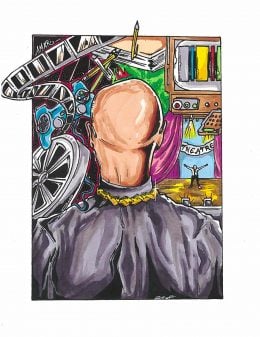Three Months (2022) – Film Review and Summary
“Three Months” is a vibrant coming-of-age film that explores a young man’s journey through potential HIV diagnosis, untraditional relationships, and self-acceptance in a visually compelling and emotionally resonant narrative.

Spoiler Alert: This summary and review contains spoilers.
Additionally, some images and text may include affiliate links, meaning we may earn a commission or receive products if you make a purchase.
| Director(s) | Jared Frieder |
| Screenplay By | Jared Frieder |
| Based On | N/A |
| Date Released (Paramount+) | February 23, 2022 |
| Genre(s) | LGBT, Young Adult, |
| Film Length | 1 Hour 44 Minutes |
| Content Rating | PG-13 |
| Noted Characters and Cast | |
| Caleb | Troye Sivan |
| Estha | Viveik Kaira |
| Dara | Brianne Tju |
| Dr. Diaz | Javier Muñoz |
| Valerie | Ellen Burstyn |
| Suzanne | Judy Greer |
Summary
“Three Months” is a gripping, emotionally charged narrative that unveils the life of its protagonist, Caleb, over a span of three months. The film begins with Caleb and his best friend, Dara as inseparable companions, fresh out of high school. Their journey takes a dramatic turn when Caleb, after an ill-considered hookup, finds himself in a whirlpool of anxiety and fear, waiting to discover his HIV status. During this time, Caleb forms a bond with Estha, a Hindi man he meets at support meetings. This relationship further complicates his life as Estha battles his own fears about his potential diagnosis and struggles to accept his sexuality, leading to a tangled web of affection, confusion, and tension.
Parallel to this, the film also showcases Dara’s relationship with their mini-mart boss, Suzanne, underlining the film’s theme of unconventional relationships. Moreover, the film delves into the intricacies of family dynamics, emphasizing Caleb’s relationship with his caring grandmother, Valerie, who has been his main support since his father’s passing. The storyline takes a jarring twist when Caleb’s interaction with his own mother, Edith, leads to a hurtful rejection. This stark contrast of familial relationships highlights the struggles faced by Caleb during this challenging period. Over the course of three months, as the film unfolds, viewers are drawn into Caleb’s world, experiencing his fears, hopes, and the emotional upheaval that his potential HIV diagnosis brings about.
Things To Note
Why Is “About My Father” Rated PG-13
- Dialogue: Mild dialogue
- Violence: N/A
- Sexual Content: Sexual innuendo throughout with a few sex scenes.
- Miscellaneous: N/A
Characters
Caleb

The film centers around Caleb, a witty, quirky gay teenager grappling with the possibility of being HIV positive after a questionable hookup. He becomes embroiled in a whirlpool of emotional uncertainty, which is portrayed in his journey of waiting three months for his HIV status. This time frame serves as a symbolic gestation period for Caleb, cultivating his character growth, self-understanding, and blossoming relationships.
Dara

Caleb’s best friend is a side character worth mentioning. Her vibrance and drive to protect Caleb despite the fact that his actions are painful to her is honorable. One could also make the argument she was a mechanism for enabling Caleb.
Valerie
This loving grandma has taken care of Caleb for a long while after his father’s passing.
Estha

Estha, Caleb’s love interest, is a quieter character who wrestles with inner turmoil and self-shame over his potential HIV-positive status and his own sexuality. He attempts to navigate the stormy waters of his fears by distancing himself from anything that might remotely imply his homosexuality.
Dr. Diaz
A calm and gentle physician who guides patients through the process over three months of getting tested. He hosts meetings with his husband that allow Estha and Caleb to meet.
Review
Not Who He Thought
Adding a layer of disbelief, Estha’s character takes an unexpected turn. Initially, Estha’s subtle feelings for Caleb suggest a budding romance. They share intimate moments during the support meetings they attend, which one might anticipate would strengthen their bond. However, Estha’s decision to leave for school without giving Caleb closure sends a jolt of surprise and disappointment through the viewer.
The subplot involving Caleb’s visit to his Jewish mother, Edith, further enhances this sense of unbelievable abandonment. Caleb’s mere presence seems to unsettle Edith, her discomfort palpable in her inability to maintain eye contact with him. The scene peaks in discomfort when, as Caleb holds a presumed sibling and begins to share his predicament, Edith abruptly cuts him off. The viewer is left to speculate that she might have pieced together the impending revelation but chose denial over empathy, unable to reconcile with her son’s reality due to her staunch religious beliefs.
This sequence, filled with discomfort and silent rejection, concludes with a heart-wrenching shot of Edith crying behind a closed door, incapable of comforting her son in his hour of need. The film explores these interpersonal relationships with such raw honesty that it is virtually impossible not to be a bit aghast by the harsh realities some characters choose over acceptance and understanding.
Highlights
Being Unique
One of the standout aspects of “Three Months” is its nuanced character development and the unique interactions that unfold between them. The film embraces and showcases diversity and inclusivity in a myriad of forms, from Caleb’s interracial homosexual relationship with Estha, a young Hindi man, to the interracial marriage of his grandparents. It disruptively yet elegantly showcases relationships that defy social norms and hegemony, rendering them natural and heartwarmingly relatable.
Caleb’s relationship with Estha is particularly notable for its depiction of parallel struggles, despite the differences in their cultural and religious backgrounds. It’s a bold portrayal of two young men seeking solace and open arms in a world that tends to be unforgiving.
Subplots & Characters
The side characters bring a sense of richness and depth to the storyline. Dara, Caleb’s vibrant best friend, offers a subplot of a lesbian love affair and provides a solid backbone to the narrative. Valerie, Caleb’s loving grandmother, serves as a calming and nurturing presence in his tumultuous journey. Additionally, Dr. Diaz, the gentle physician, hosts meetings that add further layers to the storyline, highlighting the importance of supportive communities and institutions.
The film effectively balances humor with the seriousness of the narrative. Caleb’s witty, often sarcastic remarks, such as his quip about a potential Taylor Swift crossover hit, “This Is What I Get Riding Bareback,” add a comedic touch that lifts the film from being too heavy or grim.
“Three Months” is a film that strikes a delicate balance between depicting the struggles of a young adult coming to terms with his potential HIV status and the exploration of relationships, friendship, and self-love. It offers a refreshing take on the coming-of-age genre by intertwining serious health concerns with an emotionally resonant storyline. This is not just a film about fear and uncertainty; it’s a testament to resilience and the power of human connections. “Three Months” is a must-see film that skillfully touches upon aspects of life often kept hidden, illuminating them with grace and wit.
An Artist’s Playground
From the outset, “Three Months” immerses viewers in a vividly rendered universe through its artsy graphics, which serve as a vibrant window into the world of Caleb and Dara. The film’s stylistic choices in wardrobe, accessories, and settings contribute to a rich visual narrative that is as compelling as the plot itself. The somewhat run-down mini-mart, where our characters find their escapades fueled by marijuana and an abundance of snacks, becomes a charming tableau of their youthful fantasies. These elements transcend mere aesthetics, transforming the art into a symbolic representation of the film’s essence – a compelling exploration of young adulthood.
On-The-Fence
Superficial Sensationalism
While “Three Months” appeals largely to the young adult demographic, one can argue that it relies excessively on sexual themes, seemingly using them as a stand-in where more substantive plot development could have been employed. Despite the talented scriptwriters behind this project, who undoubtedly possess the skills to weave intricate narratives, the movie misses an opportunity to create a truly unforgettable story. Instead, it seems to resort to superficial sensationalism, undermining its potential to resonate more profoundly with its audience.
FAQs
Does Estha ever give Caleb closure?
Unfortunately, he skirts off to school via plane.
How do Dara and Caleb make amends?
Caleb makes a poor-quality pastry and Dara lightheartedly makes him eat it too!


